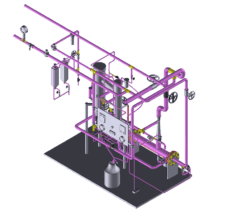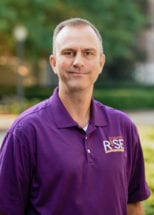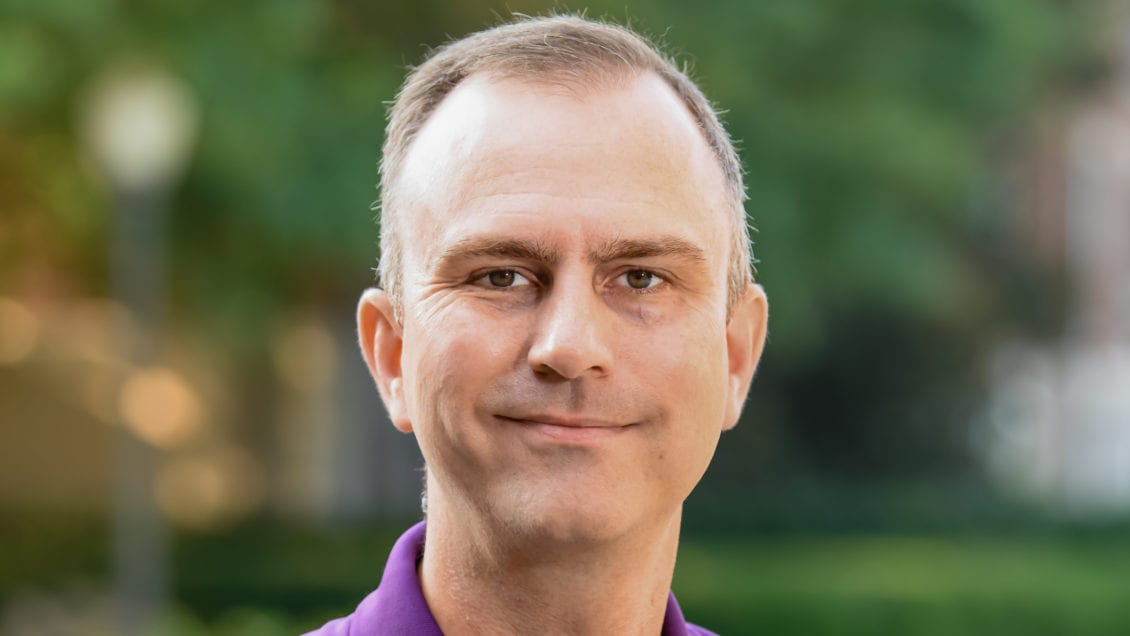Chris Norfolk, a senior lecturer in the Department of Chemical and Biomolecular Engineering, is winning the Provost Award For Outstanding Teaching With Technology.
When the pandemic hit, Norfolk made quick use of technology to adapt to social distancing. He created computer and 3D-printed models to help teach his students and keep them on track to graduation.

Robert Jones, executive vice president for academic affairs and provost, said the award is well deserved.
“Dr. Norfolk did an excellent job of using technology to enhance his teaching at a critical time for the University and its students,” Jones said. “The high ratings he has received from students and the laudatory remarks from them and his colleagues are a testament to the effectiveness of his efforts. I offer him my deepest congratulations on this award.”
For those familiar with Norfolk’s teaching, it’s just the latest way he has stood out. He has long been known as one of the most dedicated educators in the Department of Chemical and Biomolecular Engineering, said the chair, David Bruce.
“Chris helps students learn chemical engineering concepts after hours and on weekends, he takes class materials to injured students in the hospital and he creates custom educational plans for students with significant handicaps or disabilities,” Bruce said. “His care for the ‘whole student’ is beyond comparison.”
Spencer Temples, who has taken three classes with Norfolk and serves as a teaching assistant under him, said the senior lecturer has demonstrated a pattern of helping his students in any way he can.
“As a testament to this, our group emailed him in a panic at the end of last semester on a Sunday afternoon and he met with us via WebEx 10 minutes later,” Temples said. “Going above and beyond all expectations has simply become normal operating procedure to him.”

Among Norfolk’s duties is running the department’s learning labs for juniors and seniors.
“We’re one of the only labs I know of that is doing labs in-person for everyone who wants to come and do it,” he said. “That requires us to be flexible in what we are doing and how we can keep people safe.”
For those who can’t attend in person, Norfolk came up with an alternative.
He worked with two students to build 3D, computer-aided design models of lab equipment, similar to those used in industry. Students are able to rotate the interactive models as they learn how to plan experiments.
Norfolk said he will continue using the models in the course, even when the pandemic subsides and students return to the lab.
Among the courses Norfolk teaches is CHE 3190, a course on engineering materials. A major topic in the course is the arrangement of atoms to form crystals and how those arrangements affect material properties.
It can be difficult to visualize, so Norfolk created models that he 3D printed. He started off using his personal 3D printer, but it quickly became clear it was too big of a project to do at home.
Norfolk worked with the Watt Family Innovation Center to complete the printing in its Makerspace.
“I ended up borrowing all of their 3D printers while they were shut down for winter holiday to create approximately 500 individual pieces which I allow students to borrow while they are registered in the class,” he said.
When students lose or break a model, Norfolk asks them to replace it. That means students have to learn how to 3D print independently, an added bonus, Norfolk said.
Each model Norfolk has created so far is one color and shows one type of atom. But now he is also creating models of alloys that contain several colors representing different types of atoms, such as when carbon is added to iron to make steel. On that project, he is enlisting the help of Machining and Technical Services in the College of Engineering, Computing and Applied Sciences.
For Norfolk, teaching at Clemson is a way of paying back the University for helping lay a foundation for his life. Clemson is where he received a Bachelor of Science in chemical engineering in 2000 and met his wife, Noelle, who received a Bachelor of Science in graphic communications and now works in real estate in Greenville. The couple now have a 13-year-old daughter, Ava, who is in 8th grade.
After Clemson, Norfolk attended Notre Dame, where he received a Master of Science and Ph.D., both in chemical engineering.
He worked as a postdoctoral researcher at the U.S. Army Research Laboratory in Maryland before returning to the Upstate, where he worked from 2005-13 as a program director for the South Carolina Research Authority.
He has been teaching at Clemson since 2006, starting as an assistant adjunct professor. Norfolk made the jump to full-time lecturer in 2014. He credited the Office of Teaching Effectiveness and Innovation with helping him improve his teaching.
Norfolk said what he likes best about teaching is the relationships with students and helping them find their directions in life.
“Before I joined the University, I was in the defense industry, and that fit really well for me because my dad was military and his dad was a World War II vet,” he said. “I really enjoyed feeling like I was helping and part of something important. I think teaching is the same way. I feel like I’m saving the world by training the best generation of engineers possible.”
Get in touch and we will connect you with the author or another expert.
Or email us at news@clemson.edu

